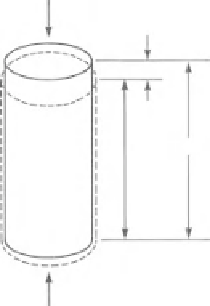Environmental Engineering Reference
In-Depth Information
The use of effective stresses with the Mohr-Coulomb fail-
ure criterion has proven to be satisfactory when dealing
with saturated soils in engineering practice. Two indepen-
dent stress state variables are required to define the stress
state and consequently the shear strength of an unsaturated
soil (Fredlund et al., 1977).
Numerous shear strength tests and other related studies
on unsaturated soils have been conducted during the past
30 years. This section presents a brief review of studies
related to the shear strength of unsaturated soils. The shear
strength testing of an unsaturated soil can be viewed as
occurring in two stages. The testing procedures are simi-
lar to those used when testing saturated soils. The first stage
takes place prior to shearing when the soils can either be
consolidated to a specific set of stresses or left unconsoli-
dated. The second stage pertains to the control of drainage
as the soil specimen is sheared. The pore-air and pore-water
phases can be independently maintained in an undrained or
drained mode during shear.
The pore fluid is allowed to completely drain from the
specimen under drained conditions. The desire is to have
essentially no excess pore pressures in the soil during the
shear process. In other words, the pore pressure is externally
controlled
at a constant value during shear. No drainage of
pore fluid is allowed under undrained conditions. Changes
in pore pressures during shear may or may not be measured.
It is important, however, to measure or control the pore-air
and pore-water pressures when it is necessary to know the
net normal stress and the matric suction at failure. The stress
state variables at failure must be known in order to assess
the shear strength of the soil in a fundamental manner.
Many shear strength tests on unsaturated soils have been
performed without either controlling or measuring the pore-
air and pore-water pressures during shear. In some cases, the
matric suction of the soil has been measured at the beginning
of the test. These results serve only as an indicator of the
present soil shear strength since the actual stress state at
failure is unknown.
A high-air-entry disk with an appropriate air-entry value
should be used when measuring or controlling pore-water
pressures in an unsaturated soil. The absence of a high-
air-entry disk limits the ability to measure the difference
between the pore-air and pore-water pressure. The interpre-
tation of the results from shear strength tests on unsaturated
soils becomes ambiguous when the stress state variables at
failure are not known. On the other hand, shear strength
tests where the pore-air and pore-water pressures have been
controlled or measured have provided the greatest insight
into unsaturated soil behavior.
σ
y
L
0
-
L
L
0
L
σ
y
Figure 11.3
Strain concept applied to triaxial test specimen.
subjected to an axial normal stress, the normal strain in the
axial direction is defined as follows (Fig. 11.3):
L
0
−
L
ε
y
=
×
100
(11.2)
L
0
where:
ε
y
=
axial normal strain in the
y
-direction expressed as
a percentage,
L
0
=
original length of the soil specimen, and
L
=
any subsequent or final length of the soil specimen.
The measurement of lateral displacement on a triaxial soil
specimen allows the normal or longitudinal strains in the
x-
and
z-
directions to also be computed, that is,
ε
x
and
ε
z
,
respectively. It is also possible to perform simple shear types
of tests where the rotation of the specimen allows the direct
measurement of shear strain.
11.2.3 Failure Criteria and Failure Envelope
The shear strength envelope is a measure of the ability of the
soil to withstand applied shear stresses. Consequently, the
shear strength envelope is a description of failure conditions.
The soil will fail when the applied shear stresses equal or
exceed the shear strength of the soil. The above-mentioned
definition of shear strength or failure conditions may seem
straightforward, but selecting the point of failure can prove
to be a challenge.
Figure 11.4 shows typical behavioral plots for an initially
loose and an initially dense soil. The initially dense soil
shows a stress versus strain plot with a peak shear stress that
then reduces to a critical state value. The other plots show
the corresponding volume changes (i.e., void ratio changes)
that occur as deviator stress is applied to the specimen. The
question can be asked, “When did the dense soil fail?” Did
failure occur at “peak” deviator stress conditions or under
strains corresponding to the critical state? The geotechni-
cal community has wrestled over the definitions of what
11.2.2 Concept of Strain
The concept of “strain” is used in presenting triaxial test
results in the form of stress versus strain curves. Normal
or longitudinal strain is defined as the ratio of the change
in length to the original length. When a soil specimen is












Search WWH ::

Custom Search